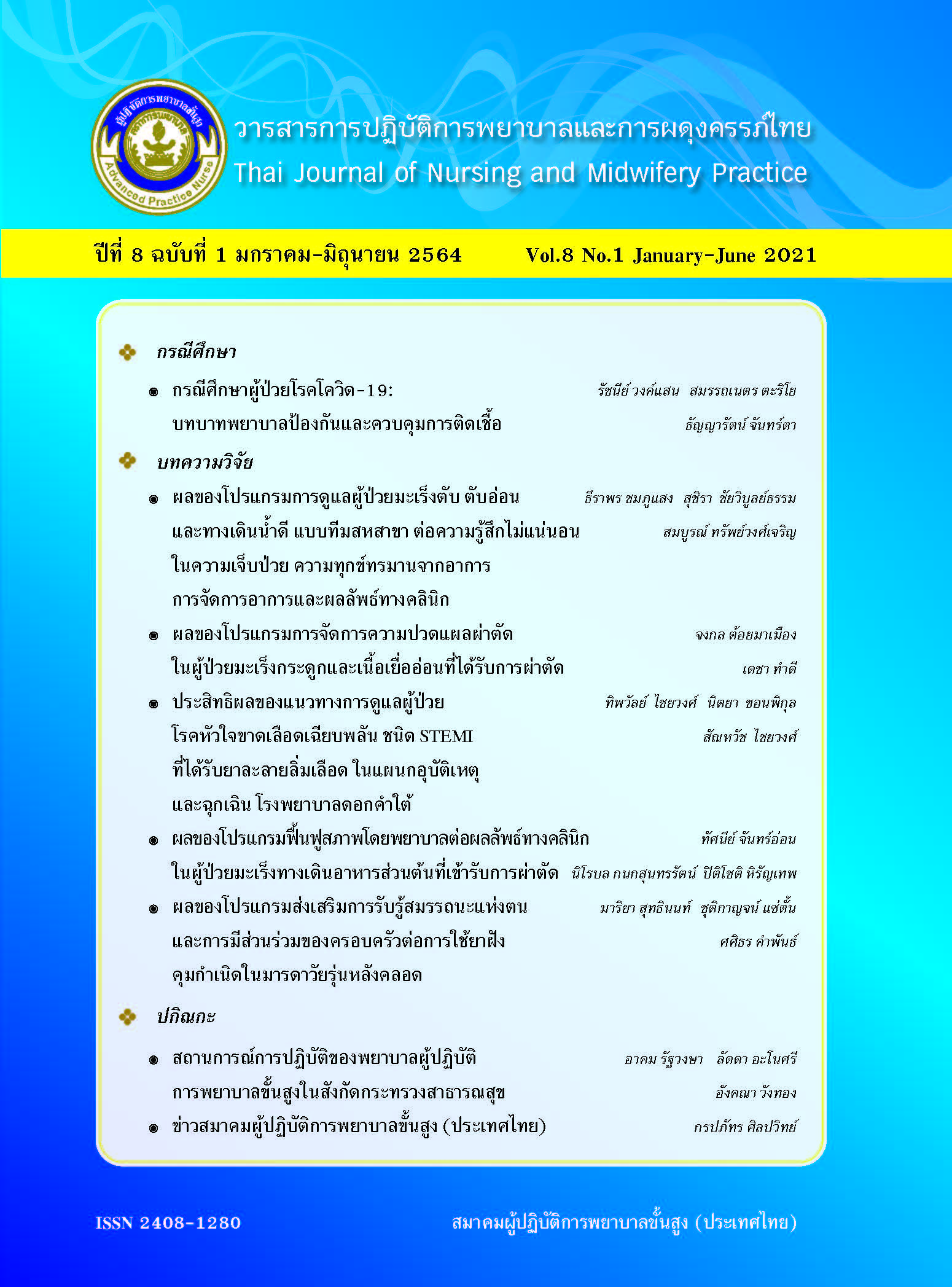Effect of Pain Management Program in Bone and Soft Tissue Tumor Patients Undergone Surgery
Main Article Content
Abstract
Nurses play an important role in pain management of patients who undergone surgery. This quai-experimental study explored the effects of pain management program in bone and soft tissue tumor patients. The gate control theory was used as conceptual framework of the study. The sample was 42 bone and soft tissue tumor patients admitted to the male orthopedic ward, during January 2018 to July 2019. The research instruments consisted of two parts: (1) pain management program; (2) data collection tools, consisting of demographic data sheet, postoperative pain management records, and patients’satisfaction assessment. Data were analyzed using descriptive statistics. The Fisher’s exact test was used to compare the proportion of pain intensity, and Wilcoxon’s rank sum test was used to compare the averages of pain scores between 24 and 48 hours of postoperative periods. Results showed that the samples who received pain management program had statistically significance decreased in pain intensity during 24 and 48 hours of postoperative periods at p<.001. The average pain scores after receiving the program within 24 and 48 hours postoperative periods, were statistically significant lower than before receiving the program at p=.027 and p=.016 respectively. The samples were satisfied with the pain management program at the high levels and they reported the effectiveness of the program at the high levels. This program help relieve pain in post-operative bone and soft tissue tumor patients.
Downloads
Article Details
References
2. Sinatra R. Causes and consequences of inadequate management of acute pain. Pain Med[Internet]. 2010[cited 2017 Nov 13];11(12):1859-71. Available from: doi: 10.1111/j.1526-4637.2010.00983.x.
3. Lindberg MF, Miaskowski C, Rustøen T, Rosseland LA, Paul SM, Lerdal A. Preoperative pain, symptoms, and psychological factors related to higher acute pain trajectories during hospitalization for total knee arthroplasty. PLoS One[Internet]. 2016[cite 2016 Oct 19];11(9):e0161681. Available from:
doi: 10.1371/journal.pone.0161681.
4. Middlemiss T, Laird BJ, Fallon MT. Mechanisms of cancer-induced bone pain.Clin Oncol[Internet]. 2011[cited 2017 Nov 18];23(6):387-92. Available from: doi: 10.1016/j.clon.2011.03.003.
5. Kalkman JC, Visser K, Moen J, Bonsel JG, Grobbee ED, Moons M. Preoperative prediction of severe postoperative pain. Pain[Internet].2003[cited 2017 Nov 16];105(3):415–23. Available from: https://doi.org/10.1016/S0304-3959(03)00252-5.
6. Daoruang B, Kanogsunthrornrat N, Junhavat D.The effects of a post-operative orthopedic pain management program on Nurse’s knowledge, patients perception on nursing practice and pain management outcomes. Rama Nurs J [Internet]. 1 [cited 2021 Feb 15];18(3):358-71. Available from: https://he02.tci- thaijo.org/index.php/RNJ/article/view/8895 (In Thai).
7. Orthopedic male 3 ward of Maharaj Nakorn Chiang Mai Hospital. Statistics of orthopedic male 3 ward. Chiang Mai: Faculty of Medicine, Chiang Mai University;2013-2015. (In Thai)
8. Nursing Department, Maharaj Nakorn Chiang Mai Hospital.Clinical practice guideline for acute pain management.Chiang Mai: Maharaj Nakorn Chiang Mai Hospital, Faculty of Medicine, Chiang Mai University; 2015. (In Thai)
9. The Royal College of Anesthesiologists of Thailand and Thai Association for the Study of Pain (TASP). Clinical guidance for acute postoperative pain management. 2011. [cited 2014 May 30]. Available from: http://www.pain-tasp.com/download/cpg/2554/CPG_Postoperative_Pain.pdf. (In Thai)
10. National VA Pain Outcomes Working Group.VHA pain outcomes toolkit 2003. [Internet]. [cited 2017 July 12] Available from: https://www.va.gov/painmanagement/docs/outcomes.doc.
11. Toimamueang J. Portfolio: outcome measurement in nursing care responsibility. Chiang Mai: Nursing Department in Orthopedic; Maharaj Nakorn Chiang Mai Hospital, Faculty of Medicine, Chiang Mai University;2017. (In Thai)
12. Zeidan F, Vago DR. Mindfulness meditation-based pain relief: a mechanistic account. Ann N Y Acad Sci. 2016 [cited 2018 June 30];1373(1):114-27. Available from: doi: 10.1111/nyas.13153.
13. Melzack R, Wall PD. Pain mechanisms: a new theory. Science[Internet].1965[cited 2017 Feb 28];150(3699):971-9. Available from: doi: 10.1126/science.150.3699.971.
14. Keolai N. Meta-analysis of nursing interventions on postoperative pain.[dissertation]. Chiang Mai: Chiang Mai University; 2002. (In Thai)
15. Sopajareeya C. Effects of relaxation technique on pain relieving during wound scrub in burned patients. [dissertation]. Chiang Mai: Chiang Mai University;1993. (In Thai)
16. Miller KM. Deep breathing relaxation: a pain management technique. AORN J[Internet]. 1987. [cited 2014 May 30];45(2):484-8.
17. Sritapan T. Effects of deep breathing relaxation on pain level in patients under gone abdominal hysterectomy and/or oophorectomy. Portfolio analysis work in responsibility. Chiang Mai: Nursing Department in Obstetrics and Gynecology; Maharaj Nakorn Chiang Mai Hospital, Faculty of Medicine, Chiang Mai University;2000. (In Thai)
18. Burns N, Grove SK. The practice of nursing research: Conduct, critique, & utilization, 4th ed. Philadelphia: W.B. Saunders, 2001.
19. Kanasutra P. Statistics for research in the behavioral sciences. Bangkok: Chulalongkorn University, 1999. (In Thai)
20. Ju W, Ren L, Chen J, Du Y. Efficacy of relaxation therapy as an effective nursing intervention for post-operative pain relief in patients undergoing abdominal surgery: a systematic review and meta-analysis. Exp Ther Med 2019. [cited 2020 Jan 1];18(4):2909-16. Available from doi: 10.3892/etm.2019.7915.
21. Suttiprapa T, Jitpanya C. The effect of symptom management program on postoperative pain during chair rest in open-heart surgery patients within the first 48 hours postoperative day. JOPN [Internet].1 [cited 2021Apr 24];6(1):1-11. Available from:https://he01.tci-thaijo.org/index.php/policenurse/article/view/21896.
22. Chotpanang A, Pattrapakdikul U. The effects of listening to favorite music on pain and vital signs in gynecologic patients after abdominal surgery. Nurs J Ministry Public Health [Internet]. 2016Aug.31 [cited 2021Apr 24];26 (2): 43-53. Available from:https://he02.tci-thaijo.org/index.php/tnaph/article/view/65675. (In Thai)
23. Niemi-Murola L, Pöyhiä R, Onkinen K, Rhen B, Mäkelä A, Niemi TT. Patient satisfaction with postoperative pain management-effect of preoperative factors. Pain Manag Nurs 2007. [cited 2017 Jan 31];8(3):122-9. Available from: doi: 10.1016/j.pmn.2007.05.003.
24. Wongkaew O. Effectiveness of implementing pain management guidelines in patients with cancer. Chiangrai Regional Hospital. [dissertation]. Chiang Mai: Chiang Mai University;2013. (In Thai).


